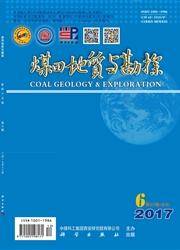

 中文摘要:
中文摘要:
二氧化氯在作为煤储层压裂破胶剂的同时,兼具降低煤的亲甲烷能力和化学增透作用.查明二氧化氯对煤储层物性改变的内在机理,对深部煤储层改造摒弃传统活性水改用高粘压裂液有重要意义.通过对二氧化氯改性前后的不同变质程度煤样的压汞和Raman 光谱测试,对比分析了煤样改性前后的孔隙结构和化学结构的变化特征.测试结果表明:煤样改性后孔隙度和孔容不同程度增加,比表面积降低;改性后煤的脂肪链的支链化程度和芳香环的缩合程度均降低,煤结构单元缺陷增加,芳碳总量相对减少.可见,煤储层物性改变的机理在于煤孔隙结构及其大分子结构发生了相应变化.
 英文摘要:
英文摘要:
Chlorine dioxide (ClO2) is effective on gel-breaking of reservoir fracturing for coalbed methane wells, aswell as on weakening the affinity for methane and increasing the permeability of coal reservoir. To investigate themechanism of ClO2 modifying the physical properties of coal reservoirs is of great significance in the recognitionof using high-viscosity fracturing fluid instead of commonly-used active water for deep coal reservoir modification.Coal samples with different metamorphic grades were selected and further examined by Raman spectra and mercuryinjection, aiming to compare the modification characteristics of porous and chemical structures of coal beforeand after the treatment of ClO2. The analytical results show that: (1) The porosity and pore volume of coal sampleswere enhanced to varying degrees, while the specific surface area decreased. (2) The branching degree of aliphaticchains and condensational degree of aromatic rings of the post-modified coals both saw a decrease. Additionally,the defect of structural units increased, while the total amount of aromatic carbon reduced. Thus, the mechanism ofClO2 modifying the physical properties of coal reservoir lie in the corresponding changes of porous and molecularstructures of post-treated coals.
 同期刊论文项目
同期刊论文项目
 同项目期刊论文
同项目期刊论文
 Prospect analysis of coal mines energy saving and emission reduction based on microbial technology,J
Prospect analysis of coal mines energy saving and emission reduction based on microbial technology,J 期刊信息
期刊信息
